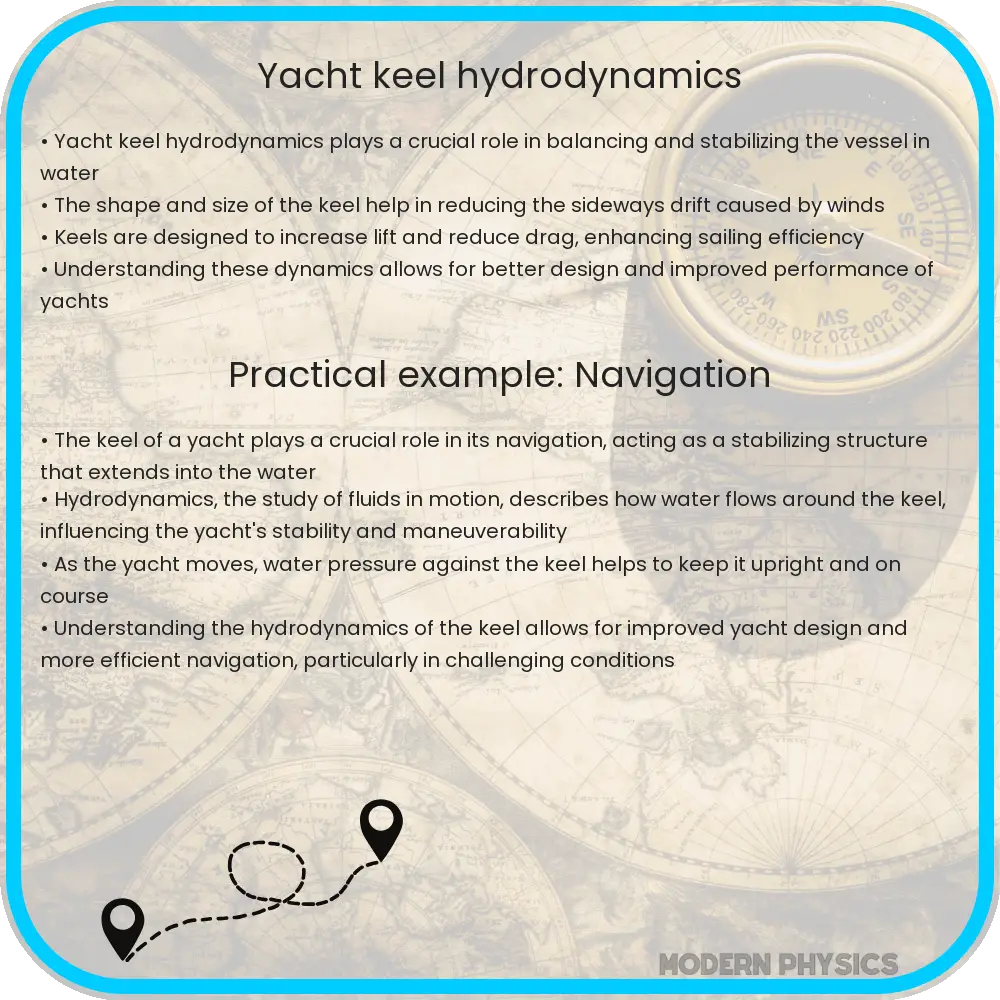Learn about yacht keel hydrodynamics and their crucial role in enhancing stability, speed, and efficiency in yacht design and performance.

Understanding Yacht Keel Hydrodynamics: The Role of Stability, Speed, and Efficiency
Yacht keels are crucial for the performance and safety of sailing vessels. They play a significant role in achieving stability, speed, and efficiency. A keen understanding of keel hydrodynamics can profoundly influence yacht design and operation, ultimately enhancing the sailing experience. This article explores the basic concepts of yacht keel hydrodynamics, focusing on how they contribute to these three critical aspects.
1. The Role of Keels in Stability
The primary function of a yacht keel is to provide stability. As a vessel encounters wind and waves, it is subjected to various forces that can cause it to heel (tilt sideways) or pitch (tilt forward or backward). Here, the keel acts as a counterbalance, helping to ensure the boat remains upright and stable. The deeper and heavier the keel, the greater the righting moment (the force that helps to bring the boat back to an upright position). This is crucial not only for the comfort of those aboard but also for the yacht’s safety, especially in challenging weather conditions.
2. Improving Speed with Hydrodynamic Design
While stability is crucial, the hydrodynamic design of a keel also significantly affects the sailing yacht’s speed. The key lies in the balance between drag (resistance created by the keel moving through water) and lift (the force that moves the boat forward). An optimally designed keel minimizes drag while maximizing lift, aiding faster and more efficient movement through water.
The shape and size of a keel play pivotal roles in its performance. Typically, modern yachts feature a “fin” keel, which is long, narrow, and deep, reducing the surface area in contact with the water and hence decreasing drag. Some high-performance yachts might incorporate a bulb at the bottom of the keel, which helps in maintaining balance and provides additional lift without significantly increasing drag.
3. Efficiency Through Keel Technology
Advances in materials and technology have also revolutionized yacht keel design, enhancing efficiency further. Modern keels are often made from composite materials, such as fiberglass or carbon fiber, which are both strong and lightweight. These materials help in reducing the overall weight of the keel, without compromising on strength or functionality, leading to better fuel efficiency and lower operating costs.
In addition to materials, the integration of computational fluid dynamics (CFD) in yacht design enables engineers to simulate and optimize keel shapes and configurations before the physical yacht is built. This ability to predict how water will flow around the keel allows designers to tweak designs to perfection, significantly boosting efficiency.
- Stability: Safety and comfort increase with a more stable yacht.
- Speed: A hydrodynamically optimized keel provides better speed performances.
- Efficiency: Modern materials and technology promote fuel efficiency and reduce operational costs.
Conclusion
In conclusion, the yacht keel is a fundamental component that directly impacts the stability, speed, and efficiency of a sailing vessel. By understanding the basics of yacht keel hydrodynamics, enthusiasts and professionals alike can appreciate the complex interplay of forces that make efficient and effective sailing possible. Future advancements in yacht design and materials promise to further enhance these aspects, making sailing an even more thrilling and enjoyable activity.
4. Enhancing Maneuverability
Another important aspect of yacht keel hydrodynamics is maneuverability. A well-designed keel not only enhances stability and speed but also improves the yacht’s ability to maneuver through the water. This is especially critical when navigating through tight spaces or dealing with sudden changes in wind and water conditions. The responsiveness of the yacht to steering commands can be significantly influenced by the keel’s design, making it an essential factor for skippers who require precision and agility in their sailing.
5. Environmental Considerations
Today’s yacht designers are increasingly aware of the environmental impacts of boating and are integrating eco-friendly practices into keel design. This includes using sustainable materials and designing keels that enhance efficiency to reduce fuel consumption and emissions. By considering environmental factors, yacht builders not only comply with global standards but also contribute to a healthier planet.
- Maneuverability: Enhanced by a keel that responds well to steering inputs, allowing for better handling of the yacht.
- Environmentally Friendly: Modern designs incorporate sustainable practices that minimize ecological impact.
In conclusion, the yacht keel is a fundamental component that directly impacts the stability, speed, efficiency, and maneuverability of a sailing vessel. A deeper understanding of yacht keel hydrodynamics enables enthusiasts and professionals to appreciate the delicate balance of forces at play, ensuring an efficient, enjoyable, and environmentally responsible sailing experience. As technology advances, we can expect future yacht designs to continue pushing the boundaries of what’s possible, innovating in ways that enhance performance while protecting our marine environments.
